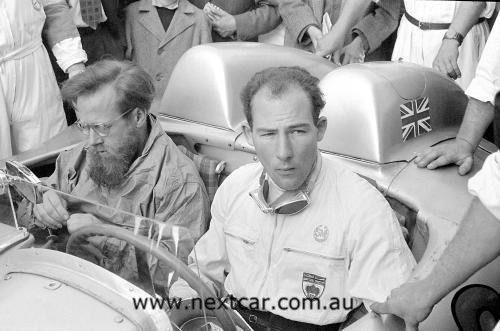Results 1 to 1 of 1
-
December 25th, 2008 10:43 PM #1



Remember that strange Mercedes-Benz “SLR Speedster” prototype spied in recent months? Well, it turns out it’s actually called the McLaren SLR Stirling Moss. The exotic model — which, in typical speedster fashion has no windscreen — will be on display at the Detroit auto show next month for all to see.
Powered by the same 650 horsepower supercharged V8 as the regular SLR 722, the car is constructed almost entirely of carbon fiber, making it good for a zero to 60 time of just 3.5 seconds, and a zero to 186 mph sprint of 26 seconds. Capable of achieving 217 mph, the Stirling Moss has vertical doors, a deployable air brake, and a manually operated tonneau cover that can cover the entire cabin, or just the passenger side.
The special edition car is the last model to come out of the Mercedes-McLaren partnership, which is all but over. With the SLR about to be discontinued, the Stirling Moss model will allow the nameplate to go out with a bang. Think of it as one final hurrah for the SLR before it’s succeeded by the all-new SLC. So Pricing is expected to be in excess of €750,000, and production will be limited to just 75 units.
The vehicle is named in honor of Sir Stirling Craufurd Moss, 79, a retired racing driver who competed for Mercedes-Benz, Maserati, and Lotus, among others.
http://www.leftlanenews.com/mercedes...ling-moss.html
Back in 1955 when Stirling Moss and Denis Jenkinson – the British team within the Mercedes-Benz racing stable – lined up at the start in the 300 SLR with start number 722 (corresponding to start time 7.22 p.m.) in the north Italian town of Brescia, nobody would have thought that this number would acquire a legendary status. Ten hours, seven minutes and 48 seconds later, the car crossed the finishing line in Brescia, having covered 1,600 kilometers at an average speed of 157.650 km/h (97.96 mph) – a sensational record time that has remained unbroken to this day and earned the team a fixed place among the all-time Mille Miglia best.
The victory was attributable not only to the perfect harmony between the two Englishmen, the great technical competence of the Mercedes-Benz racing team and the reliability of the 300 SLR but also to an ingenious idea of navigator Denis Jenkinson who had invented the prototype of all future road books. During the tests, Jenkinson had noted down all the important details of the route on three long strips of paper for each leg: the tightest corners, level crossings, dangerous hilltops, easily overlooked bypasses, etc. – plus the maximum possible speeds at these individual points. In this way, the navigator was able to warn his driver, Stirling Moss, when approaching one of the critical spots, by means of hand-signs the two had agreed prior to the race.
 iam3739.com
iam3739.com





 Reply With Quote
Reply With Quote




Did some independent research and decided to go with the white pearl crystal.... para maiba naman. ...
Toyota Innova Owners & Discussions [continued...